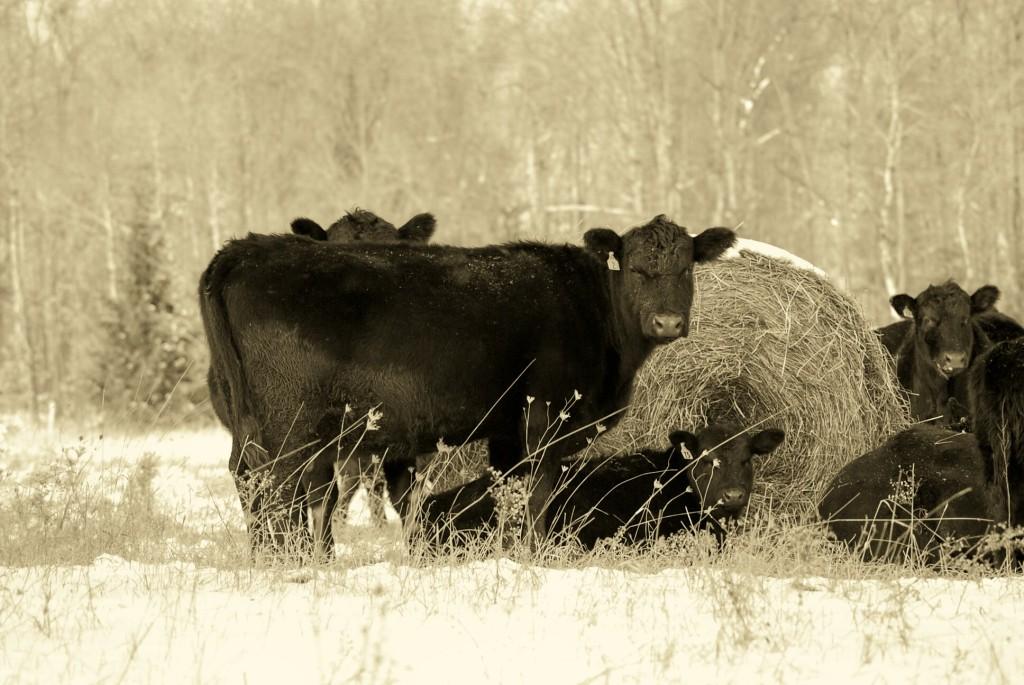Editors Note: Bale grazing on fields is a method of providing feed to beef cattle during the winter months. With this system, livestock are allowed access to bales previously placed on a field or wintering site. Here’s how Brett does it on his farm. Kathy has info on how this grazing works to improve soil and pasture health. She was going to include it, but the whole slip on the ice and face-breaking incident knocked it right out of her head. She’ll share that in another article later.
At Angus Glen Farms, LLC (www.angusglenfarm.com) the two areas where we’ve made the greatest gains in winter feeding efficiency in recent years are by reducing human and mechanical energy inputs (my time and tractor time). Several years ago we transitioned to outwintering and “bale grazing”. This strategy can be used in different ways on different farms, but in our own case we lay out a two-day supply of hay in each paddock and then rotate the cows the same as during the grazing season. We have 75 permanent paddocks across 270 acres of pasture, so we can normally set out an entire winter’s supply of hay at once. The cows start to bale graze once they finish grazing stockpiled pasture in mid-to-late December. We don’t use ring feeders, and have found that the amount of waste hay is about the same whether the cows are given a 1-day supply or a 2-day supply of hay in each paddock. The amount of waste hay increases significantly if more than a 2-day supply is available. We have also experimented the past two years with leaving the natural “jute” fiber twine on the bales to save time and keep the bales intact longer during feeding. No problems yet on our farm, but this could pose a health risk if animals consume excessive amounts of twine or become entangled – so experiment at your own risk!

Watching the 10-day forecast is important when outwintering livestock. We move the herd to sheltered, wooded areas before storms and occasionally to sacrificial paddocks during thaws. We manage several conifer plantations on the farm as “living barns” where the herd can be moved temporarily during extreme winter weather. It’s important not to repeatedly “beat up” these wooded shelter areas, nor to allow excessive accumulation of waste hay as this will eventually impact tree health.
Some other benefits of bale grazing and outwintering include:
• Cows appear to be happier and healthier by moving around all winter rather than being confined to a muddy barnyard for months at a time. They also stay much cleaner and are able to bed on waste hay in recently bale-grazed paddocks.
• Signficantly less ringworm in the herd.
• Notable increases in soil health and productivity within just one season of bale grazing on a given site.
• No more mud and manure to clean-up in the spring, and no more run-off issues from the barn yard. Both of the original dairy barns and barn yards on our farm drain directly into the Watkins Glen State Park gorge (the 2nd most visited state park in NY, after Niagra Falls). At our current herd level of 100+ head, we would need to invest in a very expensive “engineered barnyard” to avoid being a major polluter of the watershed.

Even on pastures with heavy soils, graziers should still be able to balegraze during frozen ground conditions – if the animals can be moved relatively easy back and forth from a winter yard to the pastures. Every bale that is fed on pasture is less mess to clean up in the spring and one more dose of fertility where it matters most.
Bale grazing can also be used in conjunction with planned pasture renovations and annual crops. Concentrated hay feeding over smaller pasture acreages should provide sufficient fertility and disturbance to establish new seedings or row crops with minimal tillage and fertilizer inputs. Bales can still be placed in the pasture ahead of time and rationed out by moving temporary fencing. The challenge comes with deep snow, as fences may get buried or be less effective to controlling hungry animals.
Editors Note: A version of this article appeared in the Cornell Small Farms Quarterly.





Thanks for the informative article. Some additional thoughts: We use baleage in our bale graze situation, leaving the plastic behind as we go (so we don’t need to get out the tractor). It takes less than a day with 3 or 4 people and a tractor to clean up this waste in the spring. In our case we’re looking to renovate pasture, so we set out our bales fairly close, and use a tractor to push bale waste into a compost pile while we’re cleaning up bale plastic. We’ve found that broadcast seeding directly onto this scraped area makes for great pasture by the end of the first growing season. In fact, were grazing last year’s bale graze area right now.
For setting fence into frozen ground, we use an 18 volt cordless drill with an 8″ concrete bit to dill holes for fence posts. The bit drives right in and placing the posts is easy.
Hope this helps.
You mention trouble with temporary fencing. This is what has prevented our bale grazing so far — we are in a deep snow area, and we have both small and large ruminants. We don’t expect sheep net to be 1) possible to move in frozen ground 2) in good shape after being out all winter. If we only tried to control the cattle, would the sheep destroy the bales before they got to them? What other advice have you for making even single-strand polywire for cows more effective in deep snow and frozen ground?
While this doesn’t solve the sheep problem, Grant Lastiwka of Alberta, Canada told me that they poke the fence posts into the sides of the bales themselves when the ground is frozen. That keeps the cows away from the upcoming bales so they eat the ones they’re supposed to be eating. I also use electric netting to keep my herd of 2 pet goats in pasture all summer. I’ve left the fence out through 11 Colorado winters. Though the fence doesn’t work when it’s in deep snow, it works perfectly when spring rolls around again. I’ve not seen any damage as a result of leaving the netting out.
Ross,
My starting suggestion would be to make sure you have a really good charge on the temporary fence. Electric fencing is a psychological barrier, and you want to make sure the animals are downright afraid of the fence. We used to have more problems with the smaller critters ducking under single-strand fences until we switched to an intelishock 506 fencer (unusually high output under poor conditions) – problems went away because there was too much pain associated with testing the fence.
I don’t think the sheep would waste too much hay if allowed to pick at round bales ahead of the cows – much would depend on time, ground conditions, and if twine is left on the bales. I don’t think I’d dare to leave netting on round bales – and even twine is a risk. Worth experimenting with though. And depending on the sheep, most will graze every last bit of grass that’s available before turning their attention on the hay (more so than the cows)
I have a consulting client in western New York who is going broke doing pasture renovations every year, because his bale grazing causes so much mud it destroys the forage in his paddocks. What’s the trick to bale grazing in areas with wet winters in order to preserve pastures, so he doesn’t have to plow and reseed every year?
Meg,
Sometimes the high-impact of bale grazing is a desired pre-cursor to (planned) pasture renovation or seeding some type of annual crop. But when the farmer likes things “just the way they are” and doesn’t want to spend $$ in the spring to fix and reseed feeding areas, then I suggest a combination of the following:
– move animals to sacrifice paddocks or dry lots during soft ground conditions – especially on heavy soils
– spread the bale grazing out over a wider portion of the farm to reduce ground impact and waste hay accumulation
– move animals more quickly under softer ground conditions. Yes, it’ll seem like they muck up more ground, but the damage will be less intense and it’ll be less likely that the impact will surpass the threshold for self-recovery.
– we don’t use ring feeders: partly because of the cost, but mostly because it creates a moat around every bale.
– consider smaller-framed animals? There’s quite a difference between the ground pressure exerted by a ~1500 lb frame-5.5 cow, and a ~1100 lb frame 3 cow (both of which have about the same-sized hoof). I understand that this may not be possible, depending on the breed and objectives. But I feel that our smaller cows are more gentle on the land – no matter what the ground conditions.
– Excessively compacted soils may be sufficiently remediated with a light frost seeding of tillage radish (or other Brassica), chicory, or other plants with reputed deep-penetrating tap roots.
The farmer is going to have to figure out just which of these (and other possible tactics) will work best in his/her own context. The farmer also needs to consider the costs of the alternatives (barn yard runoff/water quality issues, manure handling/storage, animal health and comfort, etc. Yes, it may be expensive to occasionally reseed a paddock here and there that gets a little too much bale grazing at the wrong time, but keeping the cows behind the barn for the winter is not without its own (significant) costs.
The last thing that I’ll say on this is to use some patience. Sometimes, particularly in late winter, some of the bale grazed areas can start to look pretty raw. It’s tempting to have a knee-jerk reaction and start discing and seeding when the ground gets dry enough – but I’ve found that things usually don’t look nearly as bad by the end of the summer as I initially thought. We’ve also found it helpful to broadcast a bit of Italian ryegrass on “overly” disturbed areas – it’s not a big expense (~$15-30/acre) and seems to do a nice job of “filling in the holes” and reseeding itself.
Bale grazing can offer both economic and environmental advantages compared to traditional intensive winter feeding. It can reduce the costs for labour, machinery and fossil fuels, both in the feeding of the bales and manure handling.
I would love to be able to do this but in this part of Tennessee, the ground rarely freezes. Yes, I know we should be grazing year round. We’re not there yet. How long does it take for the bales to break down? And do you see a weedy flush afterwards? We “park” our meat animals (some steers & sheep) in area that are thin on organic matter for the winter, usually 3 months, but we tend to get weeds for a year or two afterwards. Thanks for another great post, btw!
The amount of time for waste hay to breakdown – and what follows the breakdown – will depend on numerous factors. For “normal” residual conditions, the waste spots are generally decomposed enough to be completely re-vegetated by the end of the first growing season. Warm season weeds may dominate on the spots for a year or two, but will eventually give way to better grasses and forbs.
Comments are closed.